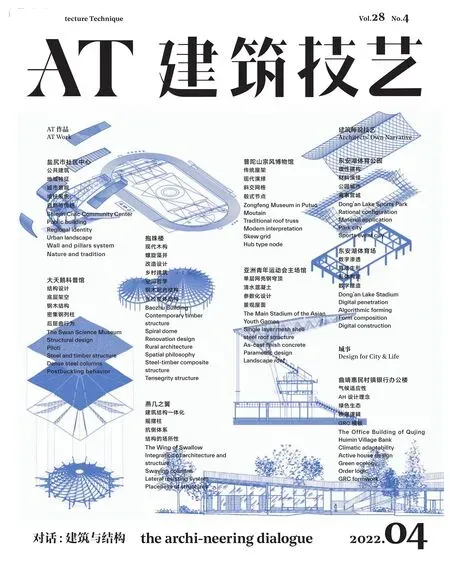从三个项目实践看建筑与结构关于地域特征的内在关联
柳泽润
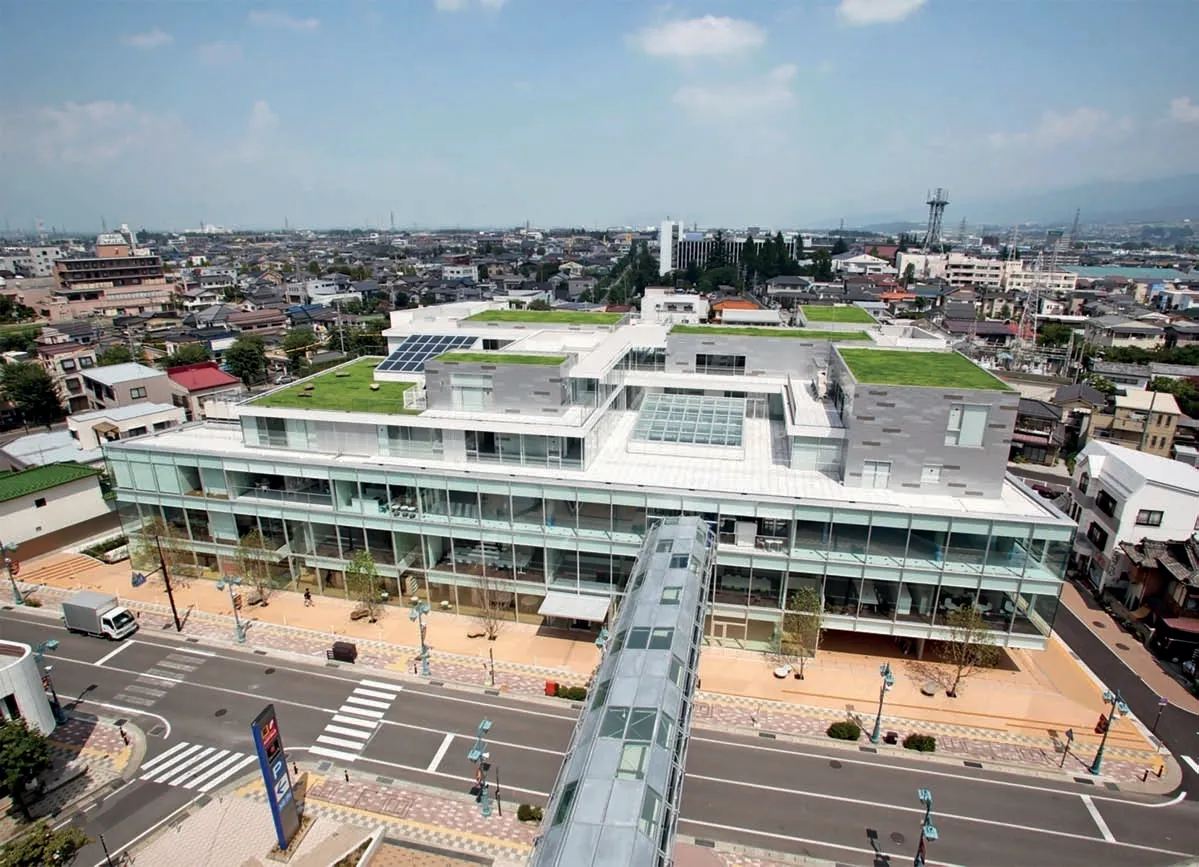
盐尻市社区中心鸟瞰 © Shigeru Ono(大野繁)
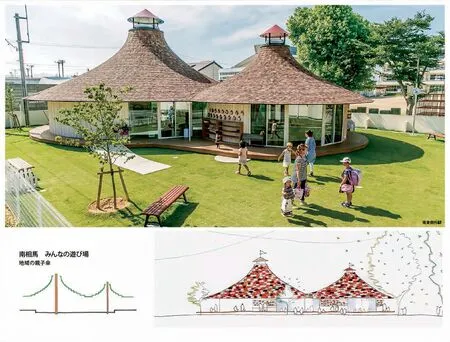
南相马市儿童乐园外观 © Kawasumi·Kobayashi Kenji Photograph Office
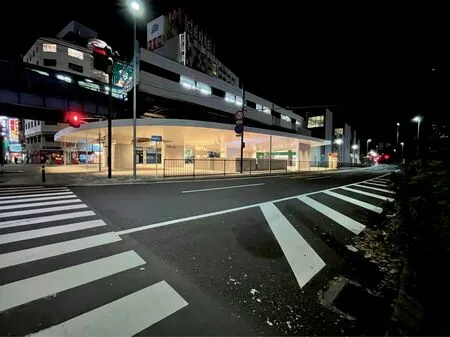
关内站北广场夜景 © Contempararies,Inc.
20世纪80年代,建筑评论家肯尼斯x 弗兰姆普顿(Kenneth Frampton)提出了批判性地方主义。20世纪80年代末,后现代主义正值盛时,并涌现出解构主义、分层城市等新思想潮流,建筑和城市设计同样有新的思想,在高科技领域也出现了新的建筑表达形式。进入21世纪后,这些“主义”消失了,各地的建筑师们在把握当地民居特点的同时,逐渐形成自己独特的想法和概念,将建筑问题与新的建筑表达联系起来的活动开始得到发展。“景观”一词出现了新的注解,例如“城市景观”“城镇景观”甚至“办公景观”,这些宽泛释义,为建立景观与建筑、建筑与城市景观之间的关系提供了契机。
1 盐尻市社区中心(Empark),2010
1.1 项目背景
盐尻市是典型的日本区域性城市,共6.6万人口。近期,该市的产业结构正被迫由第三产业转为第四产业,农业等第一产业以及某大型电子制造企业成为该市的支柱产业/企业,并且其作为葡萄酒产区正逐渐引起人们的关注。
2006年10月,该项目举行了以社区中心为主题的设计竞赛,旨在为曾经繁华的购物街及主街注入新的活力,盐尻市社区中心方案脱颖而出。直到2022年,日本各地都在持续举行此类城市复兴设计竞赛,此时距离城市中心区域空心化要求的提出已经过去了很长时间。21世纪初期,由政府主导的利用公共建筑和开放空间的“社区发展”和“城镇振兴”呈井喷态势,可以说,我们已经进入了一个全新的时代,人们不仅关注建筑的持续影响力,更期待创造基于软件的、经过深思熟虑的、为市民而设计的空间。同时,建筑与地域特征的关系变得更加紧密,其中不乏为城市而设计的结构性方案。
1.2 概念图解
2006年,我第一次到盐尻实地踏勘时,城镇十分荒芜,商业街并不热闹,站前区域同样人烟稀少。尽管周围的山脉有着壮丽的风景,但镇上几乎看不到绿植,很难想象让人们乐于聚集的场所会是什么样子。正如前文所述,项目竞赛的目标之一是复兴城市中心曾繁荣的商业区,并打造一个能将年轻人聚集的场所,作为与当地社区建立联系的标志。
为回应上述要求,我们提出了6个概念及相关图解:1)环境再生;2)开放-围合系统;3)孵化区域领袖;4)路径与岛屿;5)四个空场与庭院;6)墙柱系统的新景观。
“开放-围合系统”与软件相关,而其他概念更关注建筑的自身构架。我认为“环境再生”更加重要,即如何在同一时间轴内,建立当代建筑与当地社区的联系。对此,我在盐尻城镇的形成方式和平面构成之间建立了联系,并希望在“开放-围合系统”中通过墙柱的结构体系重现源自森林的古老力量,这也与“墙柱系统的新景观”概念一致。
由此,盐尻这个从江户时代就已存在的古老驿站城市,其历史在盐尻市社区中心的整体结构设计中起到了主导作用。同样,在御柱祭(Onbashira Matsuri)节日期间,附近的诹访神社中举行的御柱献祭仪式也影响了墙柱景观的随机排布。我们希望通过建筑的结构体系,以新的景观形式呈现盐尻已传承百年的地方特色。这一理念十分适合城镇复兴。
2020年8月,盐尻市社区中心迎来建成10周年纪念日,此时已累计接待游客超过600万人次,实现了每年接待40万游客的目标,这座建筑已然成为社区内不可或缺且受人喜爱的一部分。与此同时,“地域性特征和结构”的概念在这个作品中再次得到了充分的体现。
2 南相马市儿童乐园,2016
2.1 项目背景
2011 年3 月11 日,日本东北地区发生东部大地震。由于核电站被地震引发的海啸破坏,拥有5.5 万人口的南相马市鹿岛镇也不可避免地受到了核辐射的影响。
2013年夏天,我和建筑师伊东丰雄(Toyo Ito)一起到项目现场踏勘。在地震发生两年后,核辐射仍影响着人们的生活,附近小学和幼儿园的孩子们都在体育馆或人造草坪上玩耍,而不是在操场上。对于在海边成长的我来说,在沙滩上玩耍是孩童时期每天都会发生的事情,因此我很难想象在缺乏与沙地和土壤接触的环境下成长,会对孩子们造成多大的影响。
文化便利俱乐部有限公司(Culture Convenience Club Co.,Ltd.)作为一家私人企业,支持着由伊东丰雄和妹岛和世(Kazuyo Sejima)创立的“共有家园”(Home for All)项目。该企业提议为孩子们打造一个室内沙场,并得到了广大制造商和企业在物资以及资金上的支持,最终于2016 年将项目建成。
2.2 回应自然与传统
儿童室内沙场应采取哪种形式?临近小学及幼儿园的建筑更适合哪种形式?对我来说,这一项目非比寻常,但我仍着手绘制了草图。为回应场地周围宏伟的山脉,我将建筑的主要造型设计为双屋顶。从小学的教学楼和幼儿园的庭院都能看到这对屋顶,它的幽默感足以成为小镇的标志。结构设计同样着眼于对形式的创造,试图为每天生活在辐射和海啸恐惧之下的人们带来些许慰藉,并始终向市民敞开大门。结构又一次成为了内在地方性的表现。
在南相马,名为相马野马追节(Nomaoi)的武士节日,即所谓骑兵之战,已有数百年历史。除此之外,神道仪式也世代流传。这种激烈的骑兵战斗是此地孕育的崇高活动之一,而战士们的英勇精神所产生的力量,一定源自于他们与自然的关系。
2.3 结构与空间
建筑的曲面屋盖没有用贯通梁支撑,而是通过小部件将环形梁水平连接、堆积,并将力流向内引导,呈现出好像上升至天空的结构效果,中心的柱子也象征着直抵天空的力量。通过精致的24mm环梁将木质结构的固有强度与内部连接,使内部空间的结构体系呈现刚柔并济的效果。如果由象征性物体的相互关系所创造的空间,能够给孩子和家长们一些平静的心态和面对明天的勇气,它可能会为这座地域性建筑的持久性和可持续性赋予新的意义。
2021年12月,我再次来到这里。受新冠疫情影响,它的使用率有所降低,但我在设施的使用中依旧看到了居民对这座建筑的认可。这些美好的使用场景让我意识到,这个项目已经成功地立于当地的社区之中了。
3 关内站北广场,2022
3.1 项目背景
横滨关内最初为人所知,是因为在19世纪中叶的江户时期,马休x 卡尔布莱斯x 佩里(Matthew Calbraith Perry)曾到访此地,当时日本还是一个对外封闭的国家,后来横滨逐渐发展为繁荣的港口城市。在19世纪下半叶,日本在东京新桥和横滨之间修建了第一条铁路,关内一带填海造地,成为了贸易中心,许多产业诞生于此,一些国际公司也纷纷入驻。“关内”这一名称本就有着在某一区域内容纳外国人定居和促进区域内部交流的意思,换言之,它也代表着国际文化交流的基地。
20世纪60年代,飞鸟田一雄(Asukata Ichio)市长上任,将城市规划作为他推行的六大项目之一。城市的框架在很大程度上围绕城市设计师田村明(Akira Tamura)的设计理念形成。横滨从一个小镇转型为以关内站为中心的城市,并在此过程中完成了一系列土建项目,例如关内站的开通、横滨市政府的建设、大通公园(绿轴)以及港口的开发等。
3.2 基于城市的设计
关内站北广场项目始于2011年,当时成立了一个基于社区的设计小组委员会,由周边的各个社区协会运营,共同讨论车站的未来以及站前空间的利用。由于项目涉及多个部门,且建筑建于道路之上、高架铁轨之下,需要较为复杂的协调及解决措施,导致施工周期过长。
设计大屋顶的想法并非来自任务书的要求,而是源于一种直觉——这个场地需要通过一种形式,将关内城市的多样性与分散性整合。任务书中也没有提到广场,但我认为这个大屋顶很适合体现关内作为文化中心和开放空间的城市形象。在屋顶结构设计中,高架铁轨的复杂结构在底部被隐藏,便于人们从顶部和底部都能轻易地看到建筑。
我们想象着人们从JR关内站的检票口出来,向城市各处四散开来。我们创造了一条宽敞的流线,它以轻松的弧形环绕着高架铁轨,映射出城市的面貌,也柔和地包围着车站前来往的人们。从关内站北出口附近的任何一个地方,都可以看到这座具有城市广度的建筑。“广场”这个词会让人联想到长椅、绿植和人们放松的画面,但对我来说,建筑天花上映射的风景本身就是一个广场,它时而呈现动态影像,时而成为安静、神圣的空间。广场本就具有多面性,它会根据观者的视角、位置以及时间的不同,不断变换表达方式。这个广场所塑造的景观,与当下的关内城市氛围十分契合。
1-3,7-8,12-14 柳泽润提供
4-6 Shigeru Ono(大野繁)摄影
9-11 Kawasumi·Kobayashi Kenji Photograph Office 摄影
15-19 Contempararies,Inc.摄影
In the early 1980s,the critic Kenneth Frampton referred to critical regionalism.In the late 1980s,post-modernism was at its height,and there were many new trends such as deconstructivism or layered cities,etc.New concepts of construction began to emerge in architecture and urban planning.At the same time,there was an era of new architectural expression of high technology.In the 2000s,these "isms" disappeared,and architects in each region began to develop their unique ideas and concepts,grasping the characteristics of the local community.Gradually,activities that linked architectural issues with new expressions of architecture began to develop.New interpretations of the term "landscape" have emerged,such as "cityscape" "townscape" and even "office landscape".These broad interpretations have served as an opportunity to establish a relationship between landscape and architecture,and also between architecture and the urban landscape.
1.1 Background
Shiojiri City is a typical Japanese regional city with a population of 66 000.It has recently been forced to change its structure from tertiary to quaternary industries,with agriculture and other primary industries and a major electronics manufacturer becoming its mainstay.Recently,the town has also been attracting attention as a wine-producing region.
The theme of the design competition in October 2006 was to propose a center as a catalyst to bring back new vitality to the once-bustling shopping streets and main streets.That was how Empark was selected.Such competitions for revitalizing local cities have been held continuously throughout Japan until 2022.It has been a long
time since the hollowing out of the central districts of regional cities was first called for.The 2000s witnessed a spurt in the use of public buildings and open spaces as a means of "community development" and"town revitalization" by government officials and administrators.We have entered an era in which the question is not architecture as a formative force,but rather a more soた-ware-based,well-thought-out space for the citizens.At the same time,the question of what is the space for citizens has a great deal to do with regional characteristics,and structural solutions for the city are also included.
1.2 Concept diagrams
When I first visited the site in 2006,the town of Shiojiri was deserted.The shopping street was unpopular and the area in front of the station was sparsely populated.Although the surrounding mountains offered magnificent scenery,there was little greenery in the town.I could not imagine a place where people would gather.As mentioned earlier,one of the objectives of the competition was to revitalize the city center,the once thriving shopping district,and create a place for young people to get together,and serve as a symbol to connect with the local community.
We proposed six diagrams to answer above questions:1) contextual regeneration;2) an "opens while it surrounds" system;3)fostering leaders incubation;4) paths and islands;5) four voids and courts;6) a new landscape with wall pillars.
The theme "an opens while it surrounds system" is related to soたware,but the others are related to rather architectural composition.What I found important here was the "contextual regeneration",i.e.,how to relate contemporary architecture to the local community within a time axis.Here,I created a link between the way Shiojiri was formed and its plan composition.In "an opens while it surrounds system",I wanted to recreate the ancient power of the forest that Shiojiri has lost by using the structural system of wall pillars.The proposal "a new landscape with wall pillars" is synchronized with the proposal of creating landscape with wall pillars.
Here,the history of Shiojiri,the old inn town that has existed since the Edo period,plays a major role in the structure of Empark.Similarly,the sacred event of dedicating a pillar during the "Onbashira Matsuri" at the nearby Suwa Shrine might have influenced this random landscape of wall pillars.We wanted to use the structural system of Empark to provide a new landscape of the unique local characteristics that have been passed down for hundreds of years.It would be a good fit for a town that wishes to revitalize itself.
In August 2020,Empark celebrated its 10th anniversary,and a ceremony was held.In response to the numerical target of 400 000 visitors per year,Empark has received more than 6 million visitors.The building has become a necessary,essential,and beloved part of the community.At this moment,the concept of "regional characteristics and structure" was brought into sharp relief through this work again.
2.1 Background
On March 11,2011,the Great East Japan Earthquake struck the Tohoku region.The town of Kashima,Minamisoma city,with a population of 55 000,was no exception to the effects of radiation from the nuclear power plant that was damaged by the tsunami.
I visited the site with architect Toyo Ito in the summer of 2013.Even though it was two years aたer the earthquake,the threat of radiation had not abated.The children of the adjacent elementary school and kindergarten were playing in the gymnasium or on the artificial turf instead of on the playground.It was difficult for me to imagine how much the lack of access to the sand place and soil would affect the children as they grew up,as I had grown up near the coast and playing in the sand by the sea was a daily occurrence.
The Culture Convenience Club Co.,Ltd.(C.C.C) is a private company that endorses the activities of "Home for All" organized by Toyo Ito and Kazuyo Sejima.It proposed to provide an "indoor sand place for children,"and various manufacturers and companies supported the project by contributing materials and funds.The project was completed in 2016.
2.2 Response to nature and tradition
What form should an indoor sand place for children take? What form would be appropriate for a site adjacent to an elementary school and kindergarten? It was a very unusual situation for me,but I drew a sketch of the building.It is an architecture with couple-like roof shape in response to the majestic mountain surrounding the site.The roofs can be seen from the elementary school building and the kindergarten yard,and are humorous enough to become the symbol of the town.The structure also created a form that would bring even a little comfort to the local people living under the fear of radiation and tsunami,and a form that would always be welcoming to people.Again,for me,the structure was pursued as a manifestation of something inherent in the local character.
In Minamisoma,a heroic festival called"Nomaoi" (wild horse chasing) has been held for hundreds of years.It is the so-called cavalry battle.Shinto rituals have also been performed for generations.This fierce cavalry battle is one of the noble activities nurtured in this area,and the strength that emerges from the fierce spirit of the warriors must be nurtured in their relationship with nature.
2.3 Structure and space
Instead of supporting the catenary-curved roof with through-beams,a structural system was created by piling up small parts,connecting horizontally with ring beams,stacking up,and channeling the flow of power inward as if rising towards the sky.The central pillar also symbolizes the power straight to the sky.By connecting the inherent strength of the wooden structure to the interior with the delicate 24mm thick ring beams,the structural system creates soたness and hardness in the interior space.If the space created by the relationship between these symbolic objects can give children and parents some peace of mind and the strengths to face tomorrow,it may renew the permanence and sustainability that architecture possesses as a local identity.
I visited this work last December in 2021.Although it was not used as frequently as before due to the Covid-19,I could see that the facility was used with regional respect.Here,a pair of parents and their children were quietly and peacefully playing with the sand.This smiling scene made us understand that this work was already well established in the local community.
3.1 Background
Yokohama/Kannai was known as the place where Matthew Calbraith Perry came to Japan in the mid-19th century during the Edo period when the country was closed to the outside world.Aたerwards,the city prospered as a port town.Later,the first railroad line in Japan was built between Shimbashi(Tokyo) and Yokohama in the latter half of the 19th century.The area around Yokohama and Kannai was reclaimed from the sea and became a trading center,where many industries were born and foreign companies established their bases.The name "Kannai"also meant to contain foreign settlement within a certain area and promote exchange within the area.In other words,Kannai also represented a base for cultural exchange with foreign countries.
In the 1960s,when Mayor Asukata Ichio came to power,he promoted urban planning as one of his six major projects.The framework of the town was largely formed around the urban designer Akira Tamura.It transformed into a city with Kannai Station at its center,including civil engineering projects such as the inauguration of Kannai Station,the construction of Yokohama City Hall and Odori Park (green axis),and the development of the harbor.
3.2 City-based design
Kannai Station North Square project began in 2011 with the establishment of a community-based design subcommittee.It has been carried out by various community associations spread around Kannai Station,discussing the future of the station and the space in front of the station.One of the reasons for taking so long to complete the construction was the wide variety of departments and parties involved in the project.Meanwhile,the building was constructed on a road and under an elevated structure,which imposed institutional restrictions that took time to resolve.
My initial proposal for the large roof was not based on a request to build a roof,but rather on an intuitive feeling that the site needed a form to integrate the diversity and dissipation of Kannai city.There was no request to design a plaza either,but I thought the large roof would be appropriate to embody the image of Kannai as a cultural hub and open space.In considering the structure of the roof,the complex elevated structure was temporarily removed from view from the bottom.The roof design made it easy to see the building from both the top and the bottom.
We imagined people coming out of the JR Kannai Station ticket gates,spreading out into the city.As a result,a single,generous line was created that forms a relaxed arc to wrap around the elevated railway tracks.This curve can be a screen that reflects the city and soたly surrounds the people walking in front of the station.It is also a structure with an urban expanse that can be seen from anywhere around the Kannai North Exit.The word "square" may conjure up images of benches,greenery,and people relaxing,but to me,the scenery reflected in the ceiling of the plaza itself can be a square,which sometimes appears as a dynamic image,and at other times as a quiet,sacred void.The plaza,with its multifaceted nature that changes its expression depending on the viewer's perspective,location,and time of day,is a landscape that I believe is appropriate for Kannai in this day and age.
盐尻市社区中心(Empark)建成于2010年,旨在复兴城市中心曾繁荣的商业区。为回应项目要求,设计提出了6个概念及相关图解:1)环境再生;2)开放-围合系统;3)孵化区域领袖;4)路径与岛屿;5)四个空场与庭院;6)墙柱系统的新景观。
Empark (Shiojiri Civic Communication Center) was completed in 2010,aiming to revitalize the city center,the once thriving shopping district.Six diagrams were proposed to answer above questions:1) contextual regeneration;2) an"opens while it surrounds" system;3)fostering leaders incubation;4) paths and islands;5) four voids and courts;6) a new landscape with wall pillars.
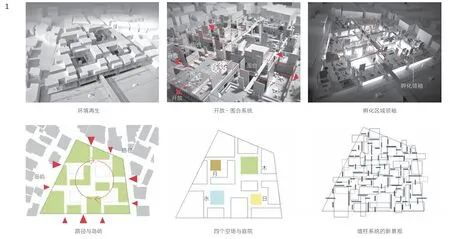
1 盐尻市社区中心6 个概念图解
设计在盐尻城镇的形成方式和平面构成之间建立了联系,并希望在“开放-围合系统”中通过墙柱的结构体系重现源自森林的古老力量,这也与“墙柱系统的新景观”概念一致。
The design created a link between the way Shiojiri was formed and its plan composition.In“an opens while it surrounds system”,and recreated the ancient power of the forest that Shiojiri has lost by using the structural system of wall pillars.The proposal“a new landscape with wall pillars”is synchronized with the proposal of creating landscape with wall pillars.
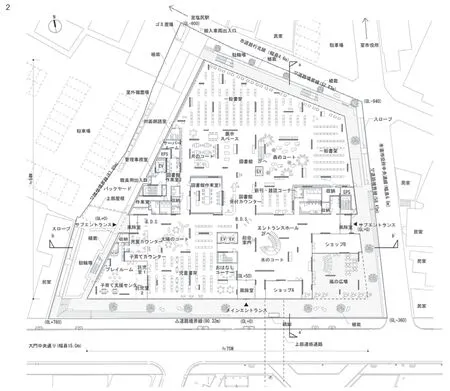
2 盐尻市社区中心一层平面图

3 盐尻市社区中心剖面图
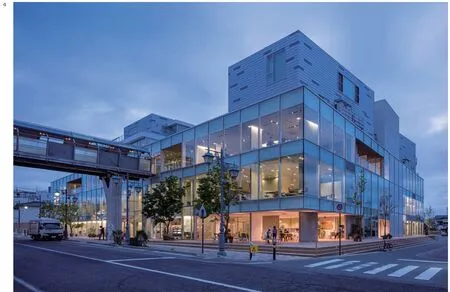
4 盐尻市社区中心夜景
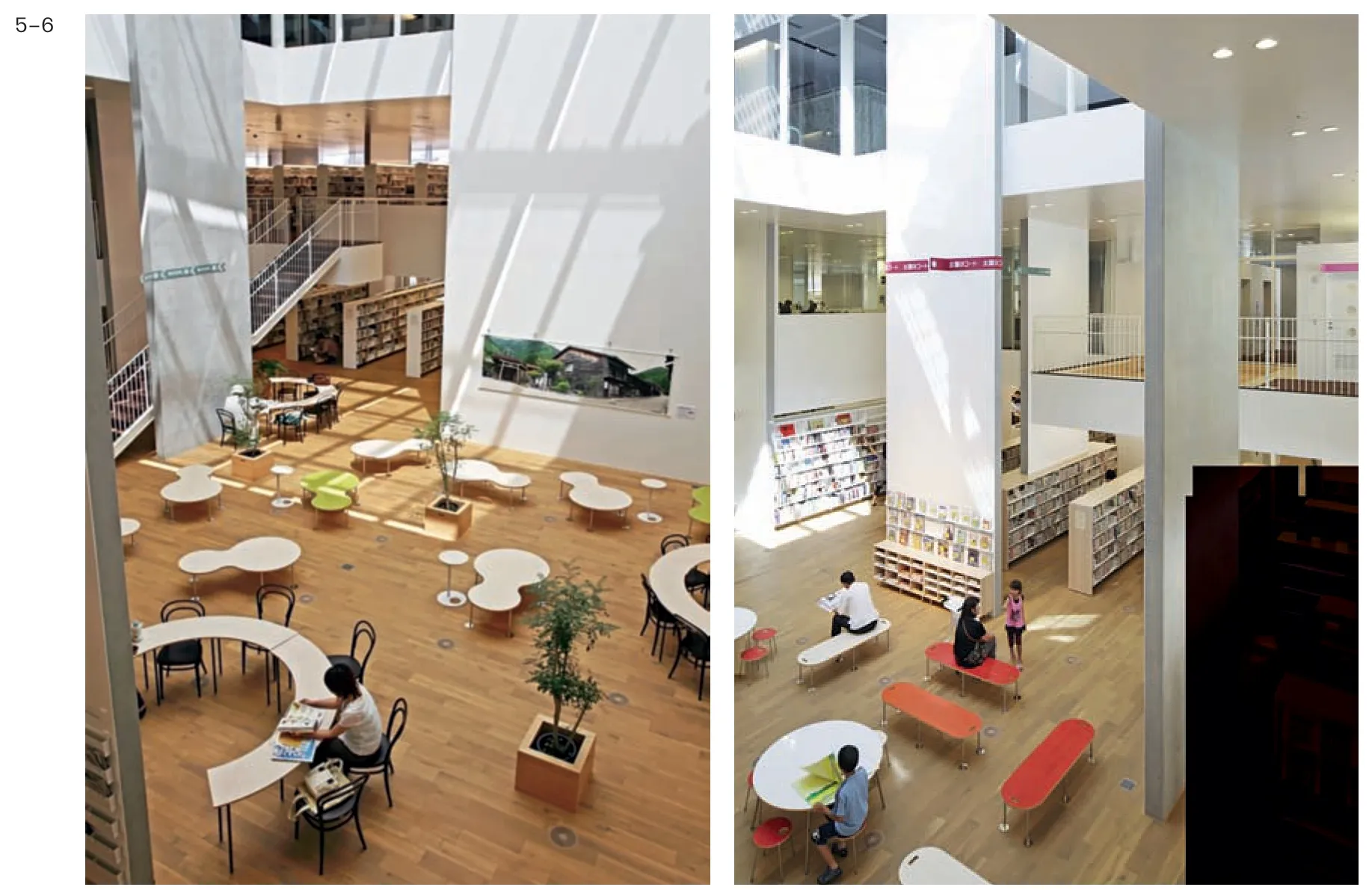
5,6 盐尻市社区中心室内空间
项目名称:盐尻市社区中心(Empark)
业主:Daimon Chuo Dori Area Urban Redevelopment Association
建设地点:日本长野县盐尻市
施工单位:Kitano Construction Corp.,Matsumoto-Doken Co.,Ltd.
层数:地上5 层,地下1 层
用地面积:4 937.45m
总建筑面积:11 901.64 m
建成时间:2010.07
摄影:Shigeru Ono(大野繁)
南相马市儿童乐园建成于2016年,建筑的主要造型为双屋顶,试图通过对结构设计形式的创造,为每天生活在辐射和海啸恐惧之下的人们带来些许慰藉,并始终向市民敞开大门。
Playpark for children in Minamisoma was completed in 2016.It is an architecture with couple-like roof shape.The structure also created a form that would bring even a little comfort to the local people living under the fear of radiation and tsunami,and a form that would always be welcoming to people.
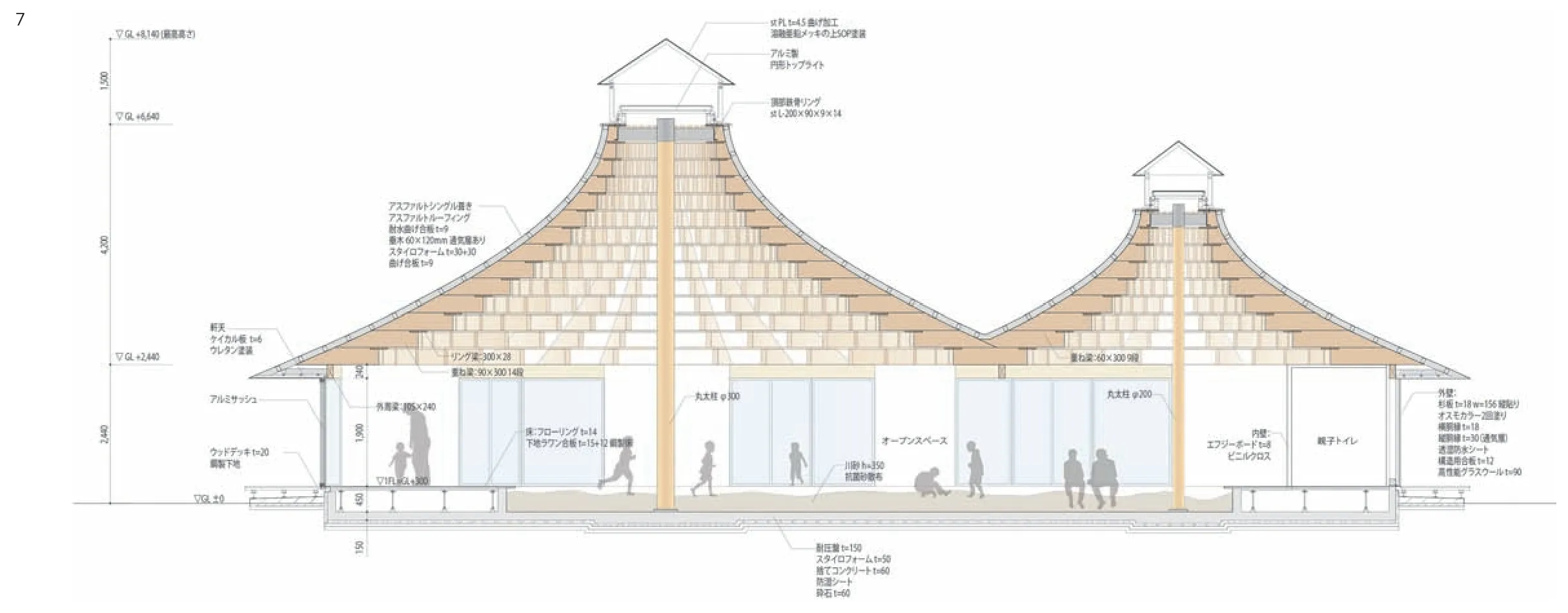
7 南相马市儿童乐园剖面
建筑的曲面屋盖通过小部件将环形梁水平连接、堆积,并将力流向内引导,呈现出好像上升至天空的结构效果,中心的柱子也象征着直抵天空的力量。通过精致的24mm环梁将木质结构的固有强度与内部连接,使内部空间的结构体系呈现刚柔并济的效果。
The catenary-curved roof was created by piling up small parts,connecting horizontally with ring beams,stacking up,and channeling the flow of power inward as if rising towards the sky.The central pillar also symbolizes the power of going straight to the sky.By connecting the inherent strength of the wooden structure to the interior with the delicate 24mm thick ring beams,the structural system creates soたness and hardness in the interior space.

8 南相马市儿童乐园曲面屋盖细部构造
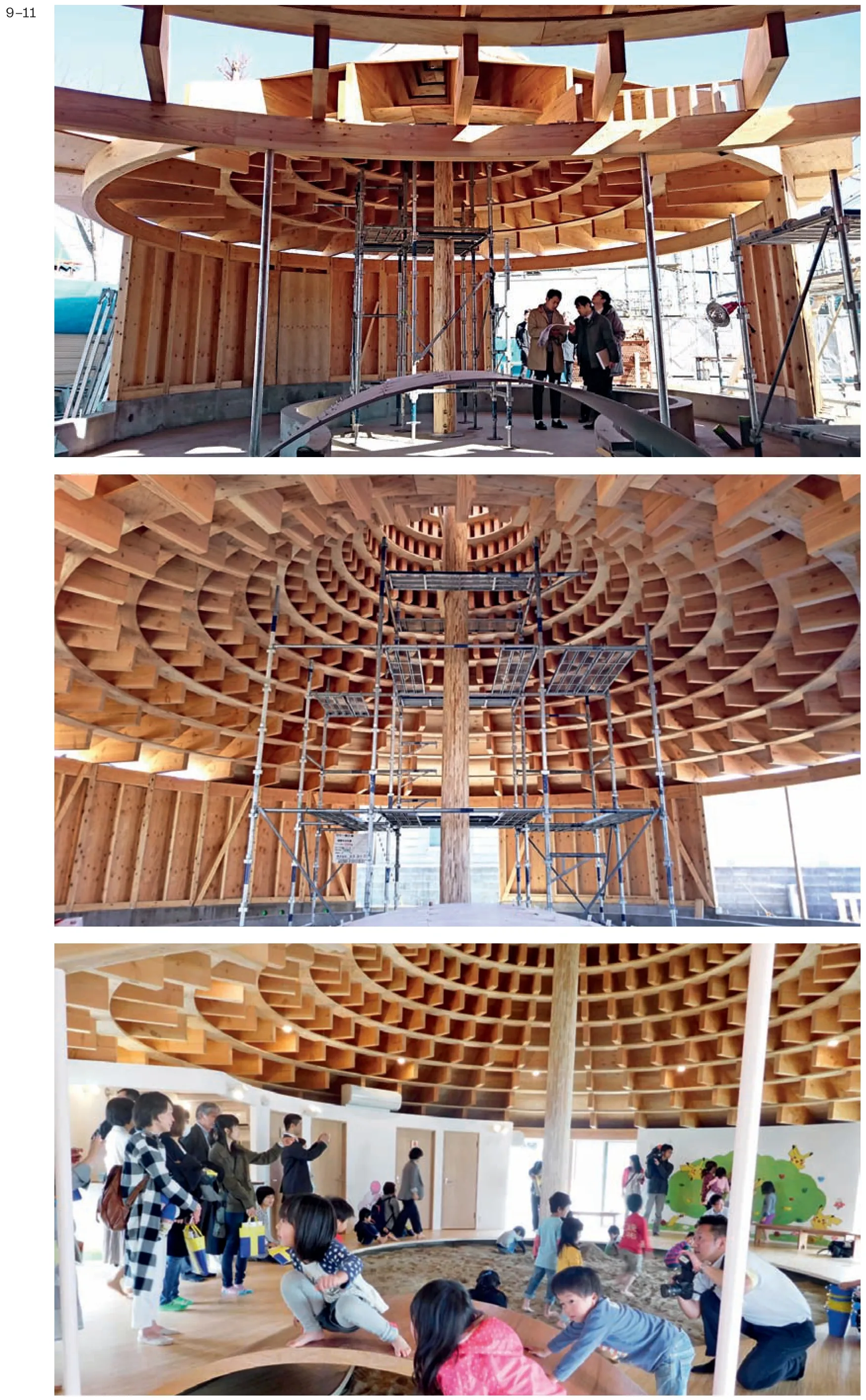
9,10 南相马市儿童乐园施工过程11 南相马市儿童乐园室内活动
项目名称:南相马市儿童乐园
业主:T point Japan Co.,Ltd.
建设地点:日本福岛县南相马市
建筑设计:Toyo Ito &Associates,Architects &contemporaries,Inc.
施工单位:Shelter Inc.
层数:1 层
用地面积:697.82m
总建筑面积:153.34m
建成时间:2016.05
摄影:Kawasumix Kobayashi Kenji Photograph Office
关内站北广场项目始于2011年,建成于2016年。设计大屋顶的想法源于一种直觉——这个场地需要通过一种形式,将关内城市的多样性与分散性整合,并体现关内作为文化中心和开放空间的城市形象。
Kannai Station North Square project began in 2011,and was completed in 2016.My initial proposal for the large roof was based on an intuitive feeling that the site needed a form to integrate the diversity and dissipation of Kannai city,and be appropriate to embody the image of Kannai as a cultural hub and open space.
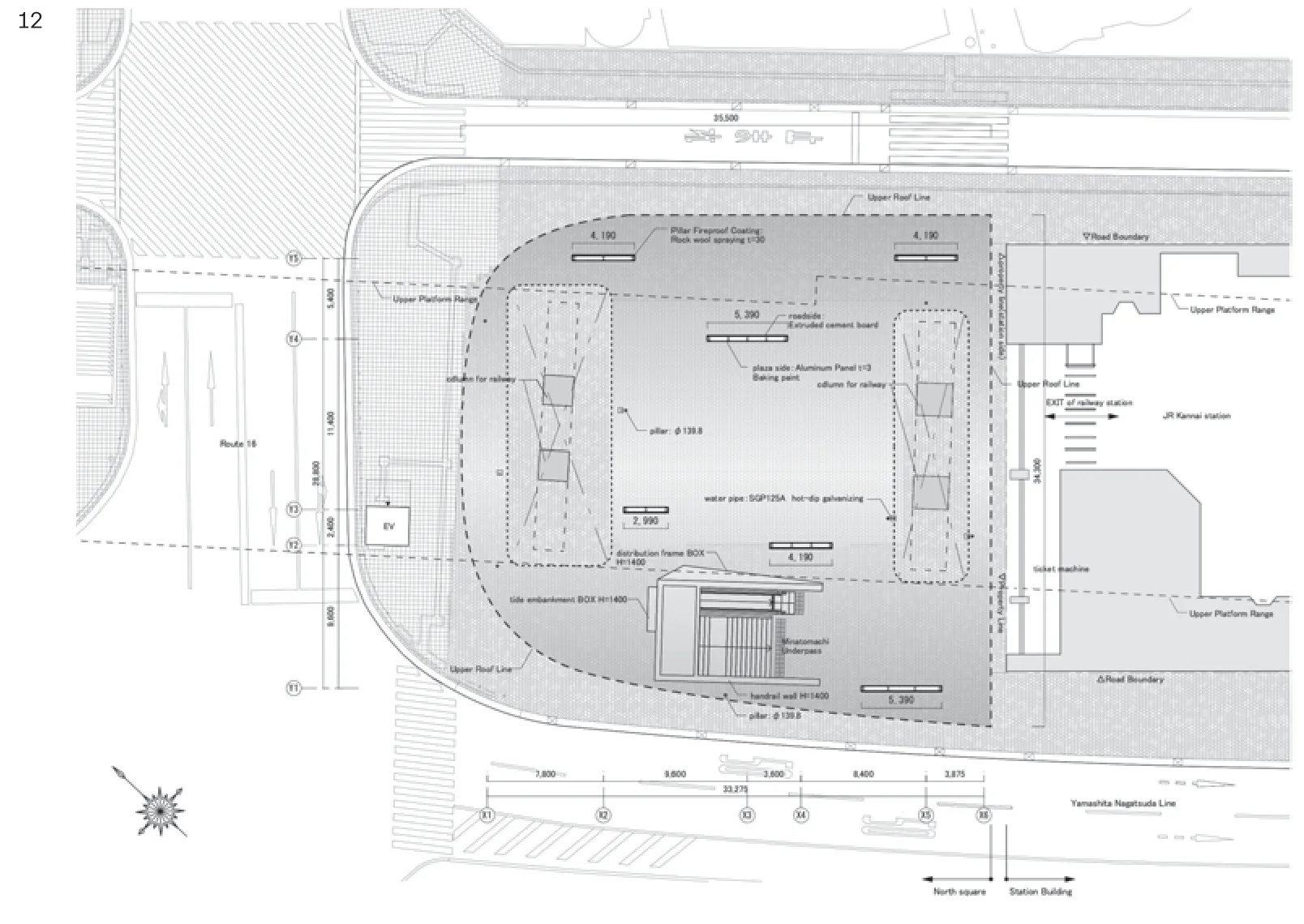
12 关内站北广场平面图
项目名称:关内站北广场
业主:横滨市
建设地点:日本神奈川县横滨市
建筑工程:Totetsu Kogyo Co.,Ltd
电气工程:Kyusyu Dengyosha Co.,Ltd.
层数:1 层
用地面积:785.32m
总建筑面积:875.71m
建成时间:2022.03
摄影:Contempararies,Inc.

14 关内站北广场剖面图
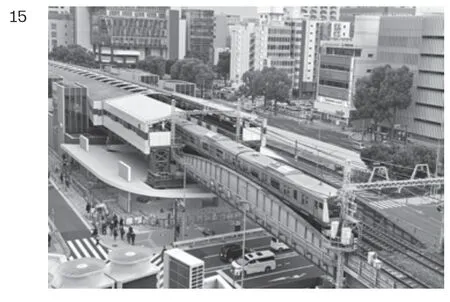
15 关内站北广场与高架铁轨
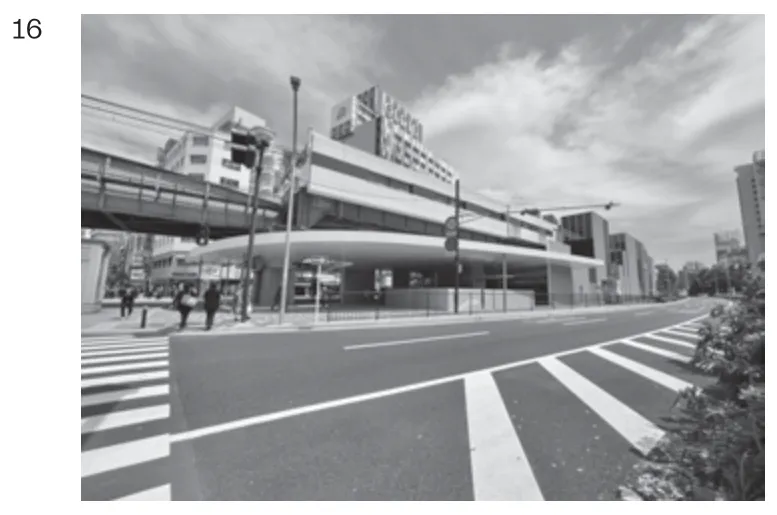
16 关内站北广场外观
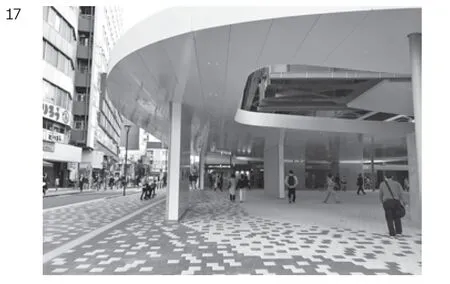
17 关内站北广场内部空间
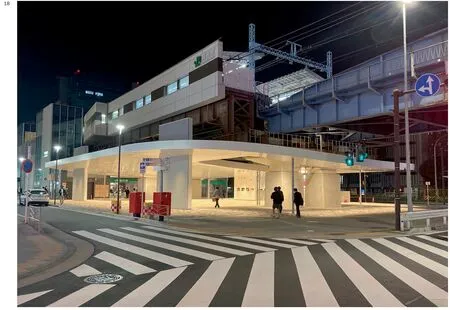
18 夜晚的关内站北广场与高架铁轨
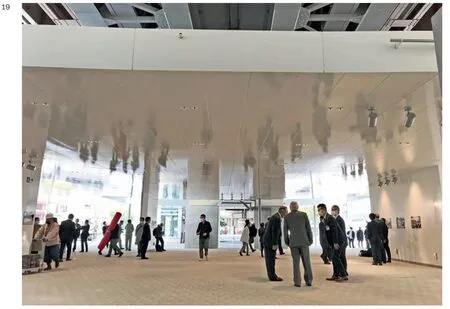
19 关内站北广场天花上映射的风景

